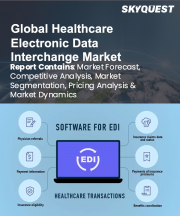
의료 전자 데이터 교환 세계 시장 규모는 2022년에 44억 달러, 2023년 48억 3,000만 달러에서 2031년에는 101억 2,000만 달러로 성장하고, 예측 기간(2024-2031년) CAGR은 9.7%를 보일 전망입니다.
선진국의 기술 발전과 함께 헬스케어 비용 절감에 대한 요구가 높아지면서 세계 헬스케어 전자 데이터 교환(EDI) 시장의 주요 촉진요인으로 작용하고 있습니다. 최종 사용자 수의 현저한 증가와 EDI 솔루션의 보급이 시장 확대에 크게 기여하고 있습니다. 인증, 데이터 무결성, 기밀성을 강화하는 웹 기반 시스템 등 혁신적인 EDI 서비스는 시장의 성장을 더욱 촉진할 것으로 기대됩니다. 또한, 미국 국가 표준의 진화에 따라 기업 간 거래에서 EDI의 기능이 강화되고 있습니다. 웹, 클라우드 기반, 모바일 EDI 등 다양한 배송 모드의 보급이 진행되고 있는 것도 시장 역학에 긍정적인 영향을 미칠 것으로 예측됩니다. 또한, 신흥국 병원의 급격한 증가는 전 세계적으로 EDI 서비스 및 솔루션의 채택을 촉진하고 있습니다.
Global Healthcare Electronic Data Interchange Market size was valued at USD 4.4 billion in 2022 and is poised to grow from USD 4.83 billion in 2023 to USD 10.12 billion by 2031, growing at a CAGR of 9.7% during the forecast period (2024-2031).
The growing demand to reduce healthcare costs, coupled with significant technological advancements in developed nations, is a major driver for the global Healthcare Electronic Data Interchange (EDI) market. A notable increase in the number of end-users and the widespread adoption of EDI solutions are significantly contributing to market expansion. Innovative EDI services, such as web-based systems that enhance authentication, data integrity, and confidentiality, are expected to further elevate market growth. Additionally, the evolution of American National Standards enhances EDI's functionality for Business-to-Business transactions. The rising prevalence of various delivery modes, including web, cloud-based, and mobile EDI, is anticipated to positively influence market dynamics. Furthermore, the surge in hospitals across developing countries is driving the global adoption of EDI services and solutions.
Top-down and bottom-up approaches were used to estimate and validate the size of the Global Healthcare Electronic Data Interchange market and to estimate the size of various other dependent submarkets. The research methodology used to estimate the market size includes the following details: The key players in the market were identified through secondary research, and their market shares in the respective regions were determined through primary and secondary research. This entire procedure includes the study of the annual and financial reports of the top market players and extensive interviews for key insights from industry leaders such as CEOs, VPs, directors, and marketing executives. All percentage shares split, and breakdowns were determined using secondary sources and verified through Primary sources. All possible parameters that affect the markets covered in this research study have been accounted for, viewed in extensive detail, verified through primary research, and analyzed to get the final quantitative and qualitative data.
Global Healthcare Electronic Data Interchange Market Segments Analysis
Global Healthcare Electronic Data Interchange Market is segmented by component, delivery, end use and region. Based on component, the market is segmented into services and solutions. Based on delivery, the market is segmented into Web and Cloud-Based Edi, Edi Value Added Network (Van), Direct (Point-To-Point) Edi, Mobile Edi. Based on end use, the market is segmented into healthcare payers, healthcare providers, pharmaceutical & medical device industries and others. Based on region, the market is segmented into North America, Europe, Asia Pacific, Latin America and Middle East & Africa.
Driver of the Global Healthcare Electronic Data Interchange Market
The global healthcare electronic data interchange market is primarily fueled by a significant advancement in the development of EDI solutions that enhance processing speed, ensure seamless workflows, elevate patient satisfaction, and boost overall productivity. Additionally, the growing trend of outsourcing EDI services worldwide, alongside an increasing emphasis on reducing manufacturing costs and minimizing waste throughout various stages of production, is anticipated to positively influence market expansion. This combination of enhanced technology and strategic outsourcing initiatives underscores the potential for continued growth and improvement within the healthcare data exchange landscape, positioning the industry for future advancements and increased efficiency.
Restraints in the Global Healthcare Electronic Data Interchange Market
The global healthcare electronic data interchange (EDI) market faces significant challenges due to the elevated implementation costs associated with various EDI software solutions. These costs are exacerbated by the insufficient internal systems and clearinghouses, leading to high setup expenses that can deter potential users. Particularly in many regions, small to medium-sized service providers exhibit low adoption rates of EDI technologies, primarily due to the substantial investment required for implementation. This reluctance to invest represents a critical barrier to market expansion, as it limits accessibility and slows the overall integration of EDI systems in the healthcare sector.
Market Trends of the Global Healthcare Electronic Data Interchange Market
A key market trend in the global healthcare electronic data interchange (EDI) market is the increasing adoption of cloud-based solutions among healthcare providers and payers. This shift is driven by the need for improved interoperability, streamlined operations, and enhanced data security. As organizations aim to reduce administrative costs and optimize patient care workflows, they are turning to cloud-based EDI systems that offer scalability, real-time data exchange, and integration with existing electronic health record (EHR) systems. Furthermore, the rise in telehealth services and remote patient monitoring is fueling demand for efficient electronic transactions, further solidifying the role of EDI in modern healthcare.